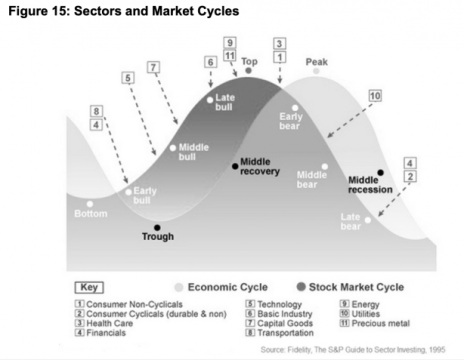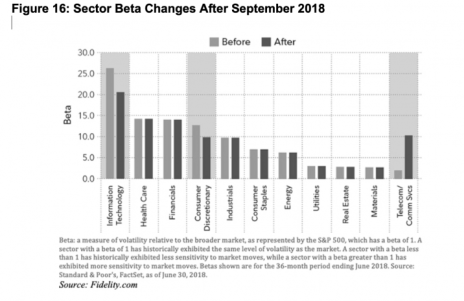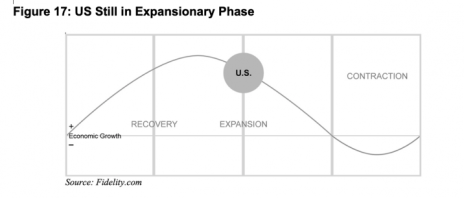Here we’ll discuss a few strategies that are favored by long-term investors as well as folks who may be interested in short-term investing.
Sector Investing
Some investors like to trade stocks, based on their predictions for the economy, certain industries, or the market as a whole. Those focused on buying stocks in ‘bullish’ sectors or industries will pay attention to the current economic cycles.
As you can see from the chart below (Figure 15), during certain market cycles, some sectors do better than others.
Fortunately, for investors trying to capture the biggest gains during the bullish periods, there are hundreds of sector mutual funds or exchange-traded funds (ETFs) from which to choose.
The list of available sector funds usually includes technology, financial, consumer cyclical, consumer staples, utilities, energy, natural resources, healthcare, real estate, and precious metals. Note that each of these can be subdivided into even smaller sectors.
There is voluminous data on successful sector strategies, such as the huge gains from technology investing in the late 1990s and real estate investing in the early-to-mid-2000s. But we all know what happened to those sectors when technology went bust, and when the most recent recession hit. That’s the risk in sector investing. When the decline happens, it usually occurs quickly and is accompanied by significant drops.
You only need to look at the sector’s beta (volatility, as compared to the S&P 500) to ascertain the predicted volatility of the sector. In September of 2018 several important changes were made to the Global Industry Classification Standard (GICS®), changing the forecasted beta of several sectors as shown in the graph below (Figure 16).
The advantage to sector investing is diversification using a professional manager when you are not well-versed on a particular industry, as well as the potential for substantial gains when that sector excels. But the downside is significant risk, should you be on the wrong side of the bet.
For prudent investors, you might consider adding sector investing to your portfolio, but keep the allocation to maybe 5% of your holdings for each sector. You can also diversify by employing certain sectors for longer-term investing (those that are least volatile) and others for your short-term, more speculative funds.
Cyclical Investing
Like Sector Investing, Cyclical Investing is a strategy dependent on certain economic cycles. But in Cyclical Investing, instead of using mutual funds and ETFs, many investors prefer to buy and sell companies whose fortunes grow and wane, according to specific economic cycles.
For instance, let’s look at my first chart in this section, depicting sectors that do well during different economic cycles. In an Early Bull market cycle and Economic Trough, investors generally favor Financials, for example. Consequently, during those cycles, you may want to buy investment and asset managers. With the idea that the economy will be improving, more folks will flock to the stock markets, sending the shares of brokerage houses higher.
Yet, between an Economic Recovery and Recession, and a Middle Bear stock market, investors will favor safer, more staid stocks, such as Utilities.
The following chart (Figure 17) shows that we are still in an expansionary economic phase, and we continue to be in a bull stock market, but we may be beginning a move into the next phase. If that is correct, we’ll see investors becoming more conservative, favoring larger, established companies, especially those that pay dividends.
The key is to be aware of the macro environment for the stock market as well as the economy. The old adage of ‘buy and hold’ no longer works in our global economy, where news from across the world can rock our markets.
Seasonal Investing
This section is more appropriate for short-term investors, or traders, than for long-term holders of stocks. And there are many seasonal trends (movements during certain times of the year) that traders watch to produce incremental gains.
One of the contributors to Wall Street’s Best newsletters is Jeffrey Hirsch, editor of The Stock Trader’s Almanac. Jeffrey—like his father Yale, who founded the newsletter—is a statistician. He parses market data and is an expert of seasonal trading. In his newsletter, Jeffrey often addresses many of the old stock market adages, including:
- Santa Claus Rally (stock market rallies in December, usually the last week). The truth: According to The Stock Trader’s Almanac, since 1950, the average gain for this period of the year has been 1.3%, and since 1969, it has generated positive returns 75% of the time.
- Sell in May and Go Away (November 1 – April 30 are considered the best months of the year for the markets). The truth: A report by Barclays found that average returns from 1970-2017 were stronger between November and April than they are in May through October.
- The January Barometer (as goes January, so goes the rest of the year). The truth: According to Fidelity, in regard to the U.S. markets, “an up January has generally been bullish for stocks, particularly when the market has gained more than 5% in January.” Since 1945, the January barometer held true 75% of the time when the market was up in January. But, declines in January have not reliably predicted a weaker year.
- The Presidential Market Cycle (first year following a presidential election is usually the worst, with the third and fourth years seeing above-average performance). The truth: History bears out the cycle; but with President Trump, the pattern changed. Whether or not that will continue into the future remains to be seen.
- October is a Scary Month (many market crashes have occurred in October—Panic of 1907, Black Tuesday 1929, Black Thursday 1929, Black Monday 1929 and Black Monday 1987). The truth: October is the most volatile month. According to CFRA Research from 1950 to present day, “The S&P 500 on average registers more daily moves of at least 1% in October than in any other month.” On the flip side, however, going back to 1950, the S&P 500 has averaged a gain of 0.7% in October, according to The Stock Trader’s Almanac.
In addition to these market adages, there are many other seasonal trades, such as in commodities—sugar, natural gas, heating oil, grains, coffee, copper, etc.—that are influenced by seasonal weather, as well as patterns, cycles and trends in consumption, supply and demand. And there are companies like amusement parks whose profits are made in the spring and summer, giving their stocks a seasonal boost. Or retailers whose big months are the end of summer and holidays.
But as with sector and cyclical investing, timing is everything and no one is perfect at market timing. These investment strategies can be high-risk, so make sure they comprise only a small portion of your overall, long-term strategies for successful investing.



